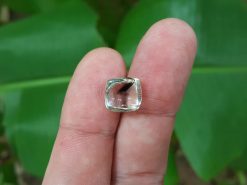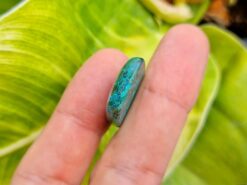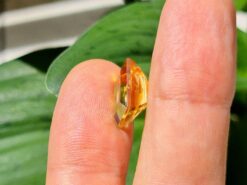Cat’s eye pezzottaite

Cat’s eye pezzottaite, marketed under the name raspberyl or raspberry beryl.
Buy natural gemstones in our gem shop
Raspberyl cat’s eye
It is a newly mineral species. I was first recognized by the International Mineralogical Association in September 2003. Pezzottaite is a caesium analogue of beryl. A silicate of caesium, also beryllium, lithium and aluminium. With the chemical formula Cs(Be2Li)Al2Si6O18.
Named after Italian geologist and mineralogist Federico Pezzotta. Pezzottaite was first thought to be either red beryl. Or a new variety of beryl: caesium beryl. Unlike actual beryl, however, pezzottaite contains lithium and crystallizes. It is in the trigonal crystal system rather than the hexagonal system.
Colors include shades of raspberry red to orange-red and pink. Recovered from miarolitic cavities in the granitic pegmatite fields of Fianarantsoa province, southern Madagascar. The pezzottaite crystals were small no more than about 7 cm / 2.8 in, in their widest dimension and tabular or equant in habit.
And few in number, most being heavily included with growth tubes and liquid feathers. Approximately 10 per cent of the rough material would also exhibit chatoyancy when polished. Most cut pezzottaite gems are under one carat (200 mg) in weight and rarely exceed two carats / 400 mg.
Cat’s eye pezzottaite Identification
With the exception of hardness 8 on Mohs scale. The physical and optical properties of pezzottaite i.e. Specific gravity 3.10, refractive index 1.601 to 1.620. Birefringence 0.008 to 0.011 (uniaxial negative) are all higher than typical beryl. Pezzottiate is brittle with a conchoidal to irregular fracture, and streaks white.
Like beryl, it has an imperfect to fair basal cleavage. Pleochroism is moderate, from pink-orange or also purplish pink to pinkish purple. Pezzottaite’s absorption spectrum, as seen by a hand-held, direct vision, spectroscope, features a band at 485–500 nm. With some specimens showing additional weak lines at 465 and 477 nm and a weak band at 550 to 580 nm.
Most, if not all, of the Madagascan deposits have since been exhausted. Pezzottaite has been found in at least one other locality, Afghanistan: this material was first thought to be caesium-rich morganite / pink beryl.
Like morganite and also bixbite, pezzottaite is believed to owe its color to radiation-induced color centres involving trivalent manganese. Pezzottaite will lose its color if heated to 450 °C for two hours. But the color can be restored with gamma irradiation.
Raspberry beryl cat’s eye effect
In gemology, chatoyancy, chatoyance or cat’s eye effect, is an optical reflectance effect visible in certain gemstones. Coined from the French “oeil de chat”, meaning “cat’s eye”, chatoyancy arises either from the fibrous structure of a material, as in cat’s eye tourmaline, or from fibrous inclusions or cavities within the stone, as in cat’s eye chrysoberyl.
The precipitates that cause chatoyance are the needles. Examined samples have yielded no evidence of tubes or fibers.The needles precipitates all align perpendicularly with respect to cat’s eye effect. The lattice parameter of the needles matches only one of the three orthorhombic crystal axes of the chrysoberyl, as a result of an alignment along that direction.
The phenomenon resembles the brilliance of a silk spool. The luminous streak of reflected light is always perpendicular to the direction of the fibres. For a gemstone to show this effect better, the shape must be a cabochon.
Round with a flat base, rather than faceted, with the fibers or fibrous structures parallel to the base of the finished gem. The best finished specimens show a single sharply. A band of light that moves across the stone when it turns.
Chatoyant stones of lesser quality display a banded effect as is typical with cat’s-eye varieties of quartz. Faceted stones do not show the effect well.
Cat’s eye pezzottaite from Madagascar
















